Introduction to Trigonometry Class 10th Notes - Free NCERT Class 10 Maths Chapter 8 Notes - Download PDF
The word trigonometry is derived from the Greek words ‘tri’ (meaning three), ‘gon’ (meaning sides) and ‘metron’ (meaning measure). Trigonometry is the study of relationships between the sides and angles of a triangle. The Class 10 maths chapter 8 focuses on explaining trigonometric ratios of sine, cosine, tangent and their mathematical characteristics and demonstrates how these functions solve problems related to heights and distances. The main purpose of these NCERT Notes is to provide students with an efficient study material from which they can revise the entire chapter.
This Story also Contains
- Introduction to Trigonometry Class 10 Notes: Free PDF Download
- NCERT Class 10 Maths Chapter 8 Notes Introduction to Trigonometry
- How to Use the Introduction to Trigonometry Class 10 Notes Effectively?
- Introduction to Trigonometry Class 10 Notes: Previous Year Question and Answer
- NCERT Class 10 Maths Notes – Chapter-Wise Links

After going through the textbook exercises and solutions, students need a type of study material from which they can recall concepts in a shorter time. Introduction to Trigonometry Class 10 Notes are very useful in this regard. In this article about NCERT Class 10 Maths Notes, everything from definitions and properties to detailed notes, formulas, figures, and solved examples is fully covered by our subject matter experts at Careers360 to help the students understand the important concepts and feel confident about their studies. These Notes are made in accordance with the latest syllabus while keeping it simple, well-structured and understandable. Check this NCERT article for complete syllabus coverage along with NCERT Books, Solutions, Syllabus, and Exemplar Problems with Solutions.
Also, read,
Introduction to Trigonometry Class 10 Notes: Free PDF Download
Use the link below to download the Introduction to Trigonometry Class 10 Notes PDF for free. After that, you can view the PDF anytime you desire without internet access. It is very useful for revision and last-minute studies.
NCERT Class 10 Maths Chapter 8 Notes Introduction to Trigonometry
The study of trigonometry is all about how angles, together with triangle side lengths, relate within right triangles. Multiple practical applications rely heavily on trigonometry for their operation, including physics together with engineering and navigation. Mainly, it deals with right-angled triangles, where one angle is always 90°.
Components of a Right-Angled Triangle
In a right-angled triangle, there are three sides, which are as follows:
- Hypotenuse: The longest side opposite the right angle.
- Base: The horizontal side.
- Perpendicular: The vertical side.
These sides help define trigonometric ratios, which relate angles to sides.
Opposite and Adjacent Sides in a right-angled triangle
Here, in the diagram below, ∠CAB (or ∠A) is an acute angle. Note the position of the side BC to ∠A. It faces ∠A. We call it the side opposite angle A. Side AC is the hypotenuse of the right triangle shown below, and the side AB is a part of ∠A. So, call it the side adjacent to angle A.
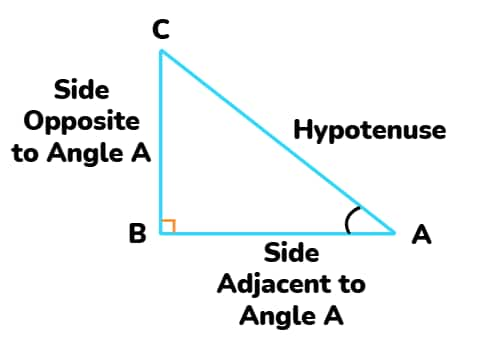
Trigonometry Ratios
The ratios of right-angled triangle sides relative to its acute angles form the basis of Trigonometric Ratios. The ratios serve to express how angle measurements relate to the lengths of triangle segments.
Six Trigonometric Ratios:
The six fundamental trigonometric ratios are:
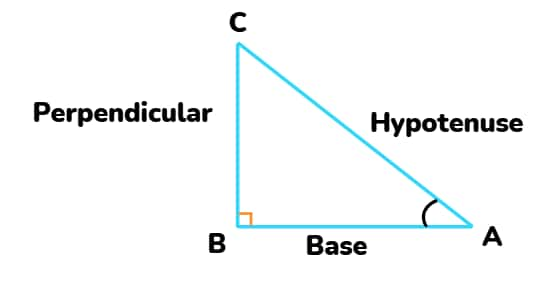
- Sine (sin θ) = Perpendicular / Hypotenuse
Sinθ = $\frac{p}{h}$ - Cosine (cos θ) = Base / Hypotenuse
Cosθ = $\frac{b}{h}$ - Tangent (tan θ) = Perpendicular / Base
Tanθ = $\frac{p}{b}$ - Cosecant (cosec θ) = Hypotenuse / Perpendicular (Reciprocal of sine)
Cosecθ = $\frac{h}{p}$ - Secant (sec θ) = Hypotenuse / Base (Reciprocal of cosine)
Secθ = $\frac{h}{b}$ - Cotangent (cot θ) = Base / Perpendicular (Reciprocal of tangent)
Cotθ = $\frac{b}{p}$ -
Many practical problems in distances, heights and navigation, along with physics, require solutions by using ratios. The ratios serve as principles to understand both trigonometric identities and functions.
Many practical problems in distances, heights and navigation, along with physics, require solutions by using ratios. The ratios serve as principles to understand both trigonometric identities and functions.
Trigonometric Ratios of Some Specific Angles
In trigonometry, certain angles commonly appear in problems, such as 0°, 30°, 45°, 60°, and 90°. Trigonometric ratios of standard angles maintain constant values, which enable smooth solutions to mathematical and practical applications.
-
Trigonometric Ratios of 45°
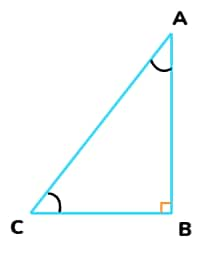
In triangle ABC, right-angled at B, if one angle is 45°, then the other angle is also 45°, i.e., ∠A = ∠C = 45°.
So, BC = AB (sides opposite to equal angles are equal)
Now, Suppose BC = AB = $a$.
Then, by Pythagoras' Theorem, AC2 = AB2 + BC2
$ a^2 + a^2 = 2a^2 $
Hence, AC = √2 $a$
Using the definitions of the trigonometric ratios:
$\operatorname{sin} 45^{\circ}=\frac{\text { Perpendicular }}{\text { Hypotenuse }}=\frac{A B}{A C}=\frac{a}{\sqrt{ 2} a}=\frac{1}{\sqrt{ 2} }$
$\operatorname{cos} 45^{\circ}=\frac{\text { Base }}{\text { Hypotenuse }}=\frac{B C}{A C}=\frac{a}{\sqrt{ 2} a}=\frac{1}{\sqrt{ 2} }$
$\tan45^{\circ}=\frac{\text { Perpendicular }}{\text { Base }}=\frac{A B}{B C}=\frac{a}{a}=1$
$\operatorname{cosec} 45^{\circ}=\frac{1}{\operatorname{sin} 45^{\circ}}=\sqrt{2 } $
$\sec45^{\circ}=\frac{1}{\text { cos } 45^{\circ}}=\sqrt{ 2} $
$\operatorname{cot} 45^{\circ}=\frac{1}{\operatorname{tan} 45^{\circ}}=1$
-
Trigonometric Ratios of 30° and 60°
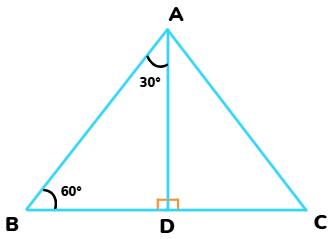
Consider an equilateral triangle ABC. Since each angle in an equilateral triangle is 60°, ∠A = ∠B = ∠C = 60°.
Draw the perpendicular AD from A to the side BC.
From the Triangles Theorem, ABD ≌ ACD
And, BD = DC, ∠BAD = ∠CAD = 30°
Now, let's suppose that AB = 2$a$.
BD = $\frac{1}{2}BC = a $
And, AD2 = AB2 – BD2 = (2$a$)2 – ($a$)2 = 3$a$2
So, AD = √3 $a$
Using the definitions of the trigonometric ratios:
Sin 30° = $\frac{Perpendicular}{Hypotenuse} = \frac{BD}{AB} = \frac{a}{2a} = \frac{1}{2} $
Cos 30° = $\frac{Base}{Hypotenuse} = \frac{AD}{AB} = \frac{√3 a}{2 a} = \frac{√3}{2} $
Tan 30° = $\frac{Perpendicular}{Base} = \frac{BD}{AD} = \frac{a}{√3 a} = \frac{1}{√3} $
Cosec 30° = $ \frac{1}{Sin 30°}$ = 2
Sec 30° = $ \frac{1}{Cos 30°} = \frac{2}{√3} $
Cot 30° = $ \frac{1}{Tan 30°}$ = √3
Same for 60°
Sin 60° = $\frac{√3}{2} $
Cos 60° = $\frac{1}{2} $
tan 60° = √3
Cosec 60° = $ \frac{1}{Sin 60°}$ = $ \frac{2}{√3} $
Sec 60° = $ \frac{1}{Cos 60°}$ = 2
Cot 60° =$ \frac{1}{Tan 60°}$ =$\frac{1}{√3} $
-
Trigonometric Ratios of 0° and 90°
When the angle is 0°, the perpendicular side becomes 0, and the hypotenuse is equal to the base.
So, in this case,
Sin 0° = $\frac{Perpendicular}{Hypotenuse}$ = 0
Cos 0° = $\frac{Base}{Hypotenuse} $ = 1
Tan 0° = $\frac{Perpendicular}{Base}$ = 0
Cosec 0° = $ \frac{1}{Sin 0°}$ = Not defined
Sec 0° =$ \frac{1}{Cos 0°}$ = 1
Cot 0° =$ \frac{1}{Tan 0°}$ = Not defined
When the angle is 90°, the base becomes 0, and the hypotenuse is equal to the perpendicular.
So, in this case,
Sin 90° = $\frac{Perpendicular}{Hypotenuse}$ = 1
Cos 90° = $\frac{Base}{Hypotenuse} $ = 0
tan 90° = $\frac{Perpendicular}{Base}$ = Not defined
Cosec 90° = $ \frac{1}{Sin 90°}$ = 1
Sec 90° =$ \frac{1}{Cos 90°}$ = Not defined
Cot 90° =$ \frac{1}{Tan 90°}$ = 0

Trigonometric Identities
Trigonometric identities are fundamental equations that hold for all values of an angle. The three most important identities are:
- cos2 A + sin2 A = 1
- 1 + tan2 A = sec2 A
- cot2 A + 1 = cosec2 A
Proof:
-
cos2 A + sin2 A = 1
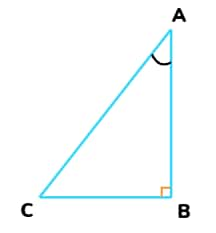
In ABC, right-angled at B,
AB2 + BC2 = AC2
Dividing each term by AC2,
$ \frac{AB^2}{AC^2} + \frac{BC^2}{AC^2} = \frac{AC^2}{AC^2} $
I.e. $ (\frac{AB}{AC})^2 + (\frac{BC}{AC})^2 = (\frac{AC}{AC})^2 $
And, from trigonometry ratios, this becomes:
⇒ (cos A)2 + (sin A)2 =1
⇒ cos2 A + sin2 A = 1
-
1 + tan2 A = sec2 A
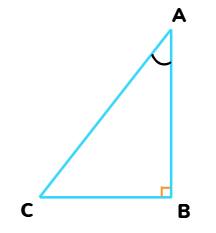
In ABC, right-angled at B,
AB2 + BC2 = AC2
Dividing each term by AB2,
$ \frac{AB^2}{AB^2} + \frac{BC^2}{AB^2} = \frac{AC^2}{AB^2} $
I.e. $ (\frac{AB}{AB})^2 + (\frac{BC}{AB})^2 = (\frac{AC}{AB})^2 $
And, from trigonometry ratios, this becomes:
⇒ 1 + (tan A)2 = (sec A)2
⇒ 1 + tan2 A = sec2 A
-
cot2 A + 1 = cosec2 A
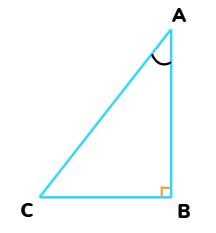
In ABC, right-angled at B,
AB2 + BC2 = AC2
Dividing each term by BC2,
$ \frac{AB^2}{BC^2} + \frac{BC^2}{BC^2} = \frac{AC^2}{BC^2} $
I.e. $ (\frac{AB}{BC})^2 + (\frac{BC}{BC})^2 = (\frac{AC}{BC})^2 $
And, from trigonometry ratios, this becomes:
⇒ (cot A)2 + 1 = (cosec A)2
⇒ cot2 A + 1 = cosec2 A
How to Use the Introduction to Trigonometry Class 10 Notes Effectively?
Trigonometry is a new topic for many students in class 10, so having clear notes makes learning easier. If you understand the ratios and angles from the start, everything after that will feel simple. These Class 10 Maths chapter 8 notes can help you revise the formulas without stress. Here are some more points on how these notes are important.
- Read the basics and understand what trigonometric ratios actually mean before memorising them.
- Keep practising angles like 0°, 30°, 45°, 60°, and 90° so the values stay in your mind.
- In higher classes, you will solve more complex trigonometric questions, so using the NCERT Class 10 Maths chapter 8 notes now will build a strong base.
- Revise from the NCERT Class 10 Maths chapter 8 notes while solving textbook questions so you can remember identities and formulas quickly.
Introduction to Trigonometry Class 10 Notes: Previous Year Question and Answer
Given below are some previous year question answers of various examinations from the NCERT class 10 chapter 8 Introduction to Trigonometry:
Question 1: Prove that $\frac{\sin \theta}{1+\cos \theta}+\frac{1+\cos \theta}{\sin \theta}=2 \operatorname{cosec} \theta$.
Solution:
LHS = $\frac{\sin \theta}{1+\cos \theta}+\frac{1+\cos \theta}{\sin \theta}$
$= \frac{\sin^2 \theta + (1+\cos \theta)^2}{\sin \theta (1+\cos \theta)}$
$= \frac{\sin^2 \theta + 1 + 2\cos \theta + \cos^2 \theta}{\sin \theta (1+\cos \theta)}$
$=\frac{(\sin^2 \theta + \cos^2 \theta) + 1 + 2\cos \theta}{\sin \theta (1+\cos \theta)}$
$=\frac{1 + 1 + 2\cos \theta}{\sin \theta (1+\cos \theta)}$
$=\frac{2 + 2\cos \theta}{\sin \theta (1+\cos \theta)}$
$=\frac{2(1+\cos \theta)}{\sin \theta (1+\cos \theta)}$
$=\frac{2}{\sin \theta}$
$=2 \operatorname{cosec} \theta$ = RHS
Hence, the given statement is proved.
Question 2: If $\sin \theta=\frac{1}{9}$, then $\tan \theta$ is equal to:
Solution:
$\sin \theta = \frac{1}{9}$.
$\sin \theta = \frac{P}{H}$
Let $P=k, H=9k$
Using Pythagoras' theorem,

$P^2+B^2=H^2$
$\Rightarrow k^2+B^2=9k^2$
$\Rightarrow B^2=80k^2$
$\Rightarrow B=4\sqrt{5}k$
$\tan\theta=\frac{P}{B}$
$\Rightarrow \tan\theta=\frac{k}{4\sqrt{5}k}=\frac{1}{4\sqrt{5}}$
Hence, the correct answer is $\frac{1}{4\sqrt{5}}$.
Question 3: Evaluate: $\frac{\cos 45^{\circ}}{\tan 30^{\circ}+\sin 60^{\circ}}$
Solution:
Given: $\frac{\cos 45^{\circ}}{\tan 30^{\circ}+\sin 60^{\circ}} = \frac{\frac{1}{\sqrt{2}}}{\frac{1}{\sqrt{3}} + \frac{\sqrt{3}}{2}} $
$= \frac{\frac{1}{\sqrt{2}}}{\frac{2+3}{2\sqrt{3}}} $
$= \frac{\frac{1}{\sqrt{2}}}{\frac{5}{2\sqrt{3}}} $
$= \frac{1}{\sqrt{2}} \times \frac{2\sqrt{3}}{5} $
$= \frac{2\sqrt{3}}{5\sqrt{2}} $
$= \frac{2\sqrt{6}}{10}$
$= \frac{\sqrt{6}}{5}$
Hence, the answer is $ \frac{\sqrt{6}}{5}$.
NCERT Class 10 Maths Notes – Chapter-Wise Links
We at Careers360 compiled all the NCERT class 10 Maths notes in one place for easy student reference. The following links will allow you to access them.
NCERT Exemplar Solutions for Class 10
NCERT Solutions for Class 10
Students should check the following links to access NCERT solutions for class 10 of Mathematics and Science Subjects.
NCERT Books and Syllabus
Before the start of a new academic year, students should refer to the latest syllabus to determine the chapters they’ll be studying. Below are the updated syllabus links, along with some recommended reference books.
Frequently Asked Questions (FAQs)
The word trigonometry is derived from the Greek words ‘tri’ (meaning three), ‘gon’ (meaning sides) and ‘metron’ (meaning measure). Trigonometry is the study of relationships between the sides and angles of a triangle. Mainly, it deals with right-angled triangles, where one angle is always 90°.
The six fundamental trigonometric ratios are:
Sine (sin θ) = Perpendicular / Hypotenuse
Sinθ = $\frac{p}{h}$
Cosine (cos θ) = Base / Hypotenuse
Cosθ = $\frac{b}{h}$
Tangent (tan θ) = Perpendicular / Base
Tanθ = $\frac{p}{b}$
Cosecant (cosec θ) = Hypotenuse / Perpendicular (Reciprocal of sine)
Cosecθ = $\frac{h}{p}$
Secant (sec θ) = Hypotenuse / Base (Reciprocal of cosine)
Secθ = $\frac{h}{b}$
Cotangent (cot θ) = Base / Perpendicular (Reciprocal of tangent)
Cotθ = $\frac{b}{p}$
- Architecture & Engineering: Individuals from the professions of Architecture and Engineering create plans for constructing buildings as well as bridges alongside roofing solutions.
- Navigation: Navigation provides a method to determine both ship-to-ship distance and physical locations.
- Astronomy: Calculating distances between celestial bodies.
- Physics & Mechanics: The analysis of wave motion, together with oscillations along with forces, forms part of Physics & Mechanics.
- Geography & Mapping: Geography & Mapping: Measuring heights of mountains and distances.
Use the mnemonic:
"Some People Have Curly Brown Hair, Through Proper Brushing."
- Sinθ = $\frac{p}{h}$
- Cosθ = $\frac{b}{h}$
- Tanθ = $\frac{p}{b}$
For reciprocals:
- Cosecθ = $\frac{1}{Sinθ}$
- Secθ = $\frac{1}{Cosθ}$
- Cotθ = $\frac{1}{Tanθ}$
Trigonometric Ratios:
Sine (sin θ) = Perpendicular / Hypotenuse
Sinθ = $\frac{p}{h}$
Cosine (cos θ) = Base / Hypotenuse
Cosθ = $\frac{b}{h}$
Tangent (tan θ) = Perpendicular / Base
Tanθ = $\frac{p}{b}$
Cosecant (cosec θ) = Hypotenuse / Perpendicular (Reciprocal of sine)
Cosecθ = $\frac{h}{p}$
Secant (sec θ) = Hypotenuse / Base (Reciprocal of cosine)
Secθ = $\frac{h}{b}$
Cotangent (cot θ) = Base / Perpendicular (Reciprocal of tangent)
Cotθ = $\frac{b}{p}$
Trigonometric Identities:
cos2 A + sin2 A = 1
1 + tan2 A = sec2 A
cot2 A + 1 = cosec2 A
Popular Questions
Courses After 12th
Applications for Admissions are open.
As per latest syllabus. Physics formulas, equations, & laws of class 11 & 12th chapters
JEE Main Important Chemistry formulas
Get nowAs per latest syllabus. Chemistry formulas, equations, & laws of class 11 & 12th chapters
JEE Main high scoring chapters and topics
Get nowAs per latest 2024 syllabus. Study 40% syllabus and score upto 100% marks in JEE
JEE Main Important Mathematics Formulas
Get nowAs per latest syllabus. Maths formulas, equations, & theorems of class 11 & 12th chapters
